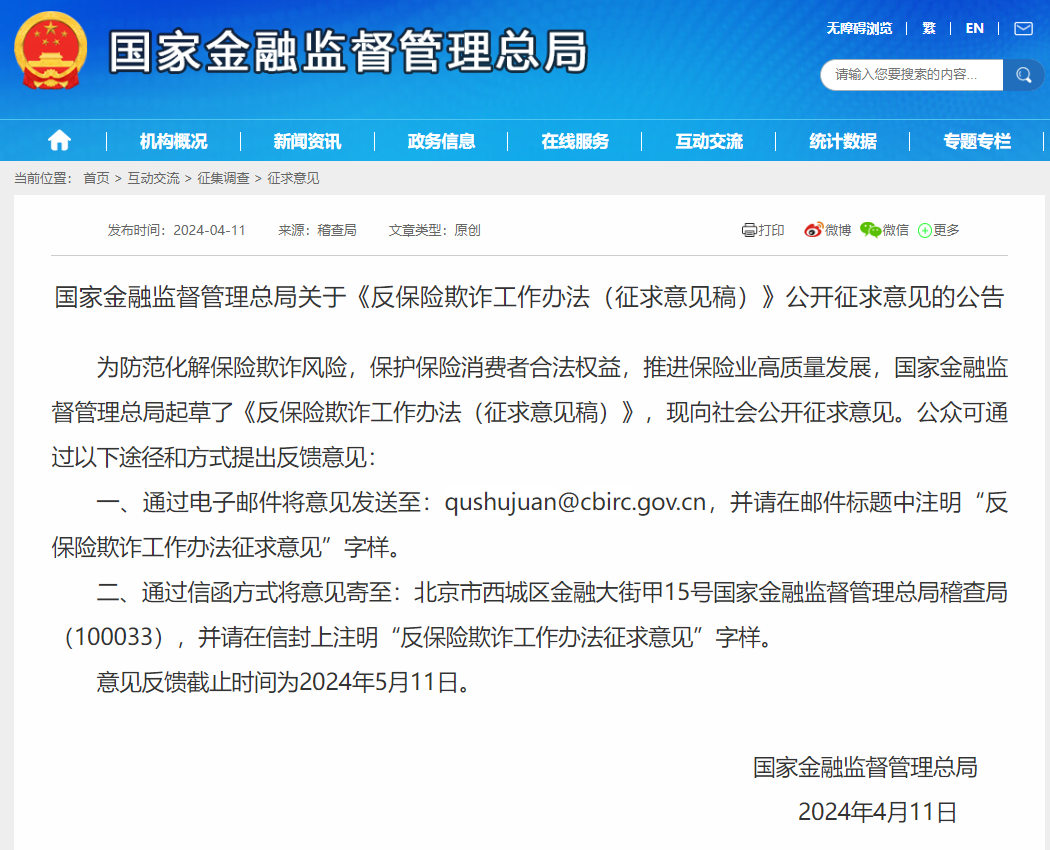
On April 11, 2024, the official website of the China Banking and Insurance Regulatory Commission (CBIRC) released a public notice regarding the "Draft Measures for Combating Insurance Fraud (for Solicitation of Comments)".

The "Draft Measures" consist of 6 chapters and 37 articles, explicitly stating that the goal of combating insurance fraud is to establish a "regulatory guidance, institution-led, industry cooperation, and multi-party coordination" integrated working system. It aims to establish a basic and sound anti-fraud institutional mechanism, effectively curb the trend of fraudulent illegal activities, significantly enhance the industry's ability to prevent and resolve fraud risks, and visibly strengthen consumer awareness of anti-fraud.
Car Insurance Fraud: Exhibiting Organized Collusion
Insurance fraud methods are complex, covert, and constantly evolving. Tactics such as pseudo base stations, coding platforms, and point walls make it difficult for insurance companies to prevent, with fraud methods being flexible, diverse, and rapidly iterating. Moreover, there's a complete fraud chain with clear division of labor upstream and downstream, forming specialized industry chains including intelligence acquisition, infrastructure services, fraud application services, monetization, and arbitrage. For instance, professional gangs in the car insurance and health insurance sectors operate across regions and companies, while "injury scalpers" form professional criminal gangs, and "proxy cancellations" form black industry chains, among others.

For instance, in some cases related to car insurance, the crimes often occur late at night in blind spots of surveillance, with vehicles usually showing signs of previous collisions or accidents. Perpetrators meticulously conspire to fabricate accidents, report false claims, apply for claims, and submit claim materials, thus increasing the difficulty of detection. Moreover, collusion between internal and external parties is also quite common. Some cases indicate that internal surveyors and loss adjusters of insurance companies provide "professional guidance" for insurance fraud, or provide false documentary evidence during accident surveys and loss assessments.
Car insurance fraud cases exhibit several characteristics:
1. Clear indications of organized crime,
with perpetrators often gathering together to commit fraud in an organized manner. For instance, in some car insurance cases, perpetrators operate relatively fixedly, choose to commit crimes late at night in surveillance blind spots, and vehicles often have old marks, making it difficult to detect due to meticulous conspiracy.
2. Covert methods of operation
, utilizing late-night hours and surveillance blind spots to increase stealth.
3. Collusion with internal personnel of insurance companies,
facilitating convenience. Internal personnel of insurance companies provide "professional guidance" for insurance fraud or provide false documentary evidence.
4. Certain degree of unreported crimes
, with many cases being detected by insurance companies through abnormal reports. There may be numerous instances of unreported fraudulent claims, indicating the existence of a large number of potential fraudulent activities that have not been discovered.
Preventive Measures Against Car Insurance Fraud
Car insurance has become a hotspot due to its simple claims procedures and short payout cycles. Preventing car insurance fraud requires coordinated efforts from insurance companies, traffic management departments, prosecution agencies, and other relevant authorities. Through strengthening management, refining procedures, leveraging functions, ensuring coordination, advancing governance, and utilizing big data, a comprehensive preventive system should be established to effectively curb insurance fraud and maintain the healthy and stable development of the insurance industry.
Insurance Companies: Enhancing Anti-Fraud Capabilities
ties
-
Establishing sound data risk control and analysis models to monitor abnormal patterns in insurance data and promptly identify signs of fraudulent behavior. Dingxiang Dinsight assists companies in risk assessment, anti-fraud analysis, and real-time monitoring, enhancing the efficiency and accuracy of risk control. Dinsight's average processing speed for daily risk control strategies is within 100 milliseconds, supporting configurable access and deposition of multi-party data. It leverages mature indicators, strategies, model experiences, and deep learning technology to achieve self-monitoring and self-iterative mechanisms for risk control. Paired with the Xintell intelligent model platform, it automatically optimizes security strategies for known risks and configures different scenario support for risk control strategies based on risk logs and data mining of potential risks.
-
Employing identity verification technology to ensure the authenticity of policyholders' identities while analyzing their behavioral patterns to identify anomalies. Dingxiang Device Fingerprinting generates unified and unique device fingerprints for each device by internally connecting multi-device information. It analyzes behaviors such as multiple account logins, frequent IP address changes, and device attribute alterations that deviate from user habits, tracking and identifying fraudulent activities. Complemented by Dingxiang atbCAPTCHA based on AIGC technology, it prevents threats such as AI brute force attacks, automated attacks, and phishing attacks, effectively safeguarding against unauthorized access, account theft, and malicious operations to protect system stability.
-
Utilizing image recognition technology to analyze photos and videos in claim documents to detect potential forgery or tampering. Dingxiang's comprehensive facial security threat perception solution employs intelligent verification based on multidimensional information such as device environment, facial information, image authentication, user behavior, and interaction status. It quickly identifies over 30 types of malicious behaviors, such as injection attacks, live counterfeiting, image tampering, camera hijacking, debugging risks, memory tampering, rooting/jailbreaking, malicious ROMs, emulators, etc. After promptly discovering forged videos, fake facial images, or abnormal interaction behaviors, it automatically blocks operations while flexibly configuring the intensity and friendliness of video verification, implementing a dynamic mechanism for strengthening verification for abnormal users.
-
Establishing cooperative mechanisms with law enforcement agencies, other insurance companies, and third-party data providers to share information and intelligence, enhancing monitoring and combating fraudulent act
Regulatory Departments: Strengthening Cooperative Efforts
tive Efforts
-
Traffic management departments should enhance business guidance and refine accident liability determination procedures, providing strict guidance to accident loss assessment service centers and urging them to strictly perform their duties, adopting appropriate accident liability determination procedures as needed to lay the foundation for subsequent case handling.
-
Prosecution agencies should play a leading role and intensify supervision of cases. Strengthening cooperation, communication, and information exchange with traffic management and control departments to identify and transfer supervision clues of insurance fraud cases to promote case resolution, promptly referring issues such as unfair law enforcement discovered to relevant functional departments.
-
Ensuring coordination between administrative and criminal penalties to achieve full coverage. Unlawfully transferring individuals involved in cases that do not meet criminal filing standards to administrative departments for administrative penalties to avoid law enforcement and judicial vacuums.
-
Promoting compliance construction and source control in line with industry characteristics. Given the widespread involvement of automobile sales and service enterprises and insurance company employees in insurance fraud, prosecution agencies should actively promote legal publicity and joint construction with enterprises.
-
Developing supervision models for automobile insurance fraud cases, establishing information sharing and cooperation mechanisms, achieving data interoperability, establishing databases of insurance fraudsters, enhancing automatic data screening and comparison functions, promptly initiating review mechanisms, and intensifying analysis efforts to discover clues and promote case resolution.
It is worth noting that the Economic Crime Investigation Bureau of the Ministry of Public Security and the Inspection Bureau of the China Banking and Insurance Regulatory Commission have jointly convened a special mobilization deployment meeting for cracking down on insurance fraud crimes. A seven-month special crackdown will be carried out from the end of April 2024 to the end of November 2024.


